WORLD CLASS COACHING
Tactical Training Games
By Renato Lopez Moreira
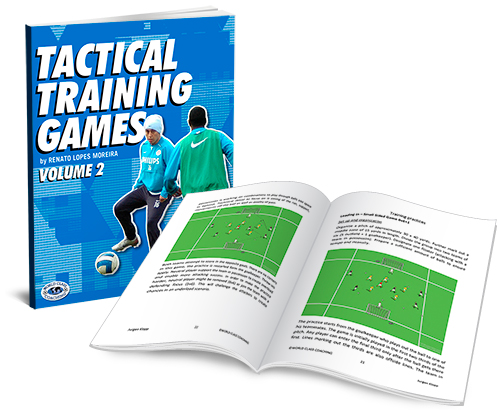
Table of Contents
PART ONE
Introduction
6v6 Games
PART TWO
5v5 games
PART THREE
4v4 Games
PART FOUR
3v3 Games
Other Game Situations
INTRODUCTION
To start, this book is not a cake recipe.
If you're reading this material and only think to apply the exercises in your team without a game model or knowing how your team want to play, just stop here.
It won't work.
The idea of these exercises is to show possibilities to train your team to achieve your goals. But you have to know your team, know where you train, where you play, who you will play against, when you will play and a lot of aspects that directly affects your day to day.
First you have to understand the game.
You have to understand the whole context to know how your team will play in each phase of the game. It is not just put your team in the field and let the players do whatever they want.
You have to know the five phases of the game and define how your team will behave on each one.
You have five moments in a game:
1) Attack (A),
2) Defense (D),
3) Transition Attack - Defense (TAD),
4) Transition Defense - Attack (TDA)
5) Stopped ball.
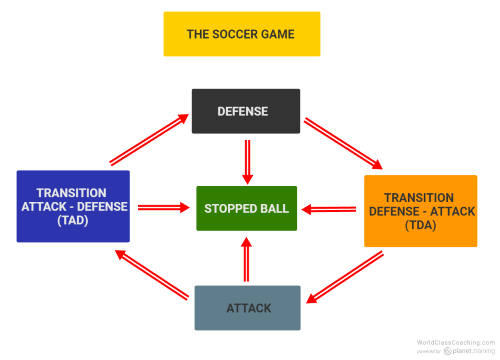
It's a big discussion about theses phases. Some authors defend that there are only three (Attack, Defense, Transition), some authors defend that thare are four phases (Attack, Defense, Transition and Stopped Ball), others authors do not consider Stopped Ball as a game phase saying the four phases are Attack, Defense, Transition Defense - Attack and Transition Attack - Defense. Like I said, big discussion.
It's up to you decide how many phases are in your game and prepare your team for them.
The progress in one exercise can easilly be afected, positivly or negativly, by the concepts that we have.
So, let's show all theses concepts and phases to start this book.
Attack is when you have the ball. The idea of the attack is to unbalance the defense, creating empty spaces and superiorities to score a goal.
There are four attitudes that your players have to have to attack:
(A) Avoid being in opponents view;
(B) Speed up the passes;
(C) Touch the ball always to an empty space;
(D) Play a organized direct game, vertical, searching the opponent's goal.
Also, you have to work with your players the four rules of action for a good attack:
(A) Ball position:
(B) Free spaces:
(C) Teammates situation:
(D) Goal to reach:
It’s very important define the behavior of your player over all kind of possible offensive tactics:
(A) Individual;
(B) Group;
(C) Team.
This behavior will define how your players will behave during the attack phase.
During the attack you have to decide if the movement will be:
(A) Sustain;
(B) Direct.
And define where at the field you are plannig to attack.
(A) Central;
(B) Corridors.
And where will be your Strong and Weak side to attack.
Once you define all the offensive actions with your team they will be ready to play Attack.
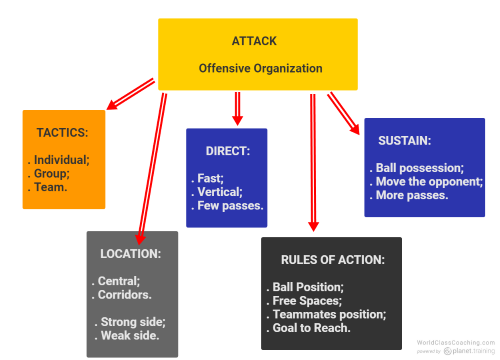
Defense is when you do not have the ball.
The defense begins when your team is attacking, because the players have to be balanced and trying to avoid inferiority as soon as the team loses the ball.
The defense must be a colective action of all team looking to avoid opponent's goal.
Defense have to slow down the attack's progression, taking the attackers far away and to a less dangerous place from their Goalkeeper.
On Defense, players have to have some attitudes and here they are:
(A) Positionate, always as possible, between the ball line and the Goalkeeper;
(B) Keep the opponent in his eye view;
(C) Fast recovery on defense;
(D) Making covers.
It’s also very important define the behavior of your player over all kind of possible defensive tactics:
(A) Individual;
(B) Group;
(C) Team.
This behavior will define how your players will behave during the defense phase.
To defend, you have to define the position where the defense will start at the field:
(A) High;
(B) Middle;
(C) Low.
And the type of marking, if it will be:
(A) Zone,
(B) Individual or
(C) Mix.
Other importante thing to decide is which type of posture your team will have on Defense:
(A) Active;
(B) Passive.
Your team will also be able to read the opponent's attack, trying to know where is his
(A) Strong side;
(B) Weak side.
And try to make the opponent to play on his weak side most of the game.
Once you define all the defensive actions with your team they will be ready to play Defense.
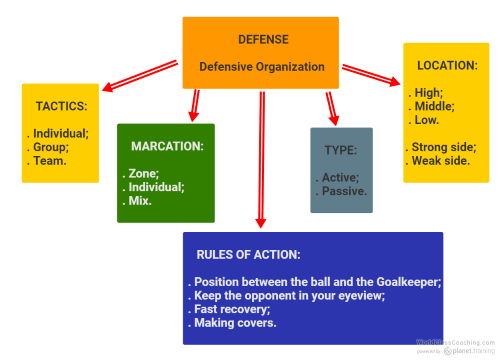
Transition game happens between the offensive and defensive moments.
Attack and Defense are antagonists with a balance between their actions during a game.
The game organization is broken with the loss of ball possession, creating a momently unbalanced situation.
When this happens the team who is attacking immediatly starts defending, changing all his functions during the game.
A well done transition searchs the good execution of counter attacks and avoid opponent's counter attack during the game.
You will have a TAD when you are attacking and loss the ball possession.
Then, you will have two options:
(A) If your team have a slow recovery you will have a defensive inferiority.
(B) If your team have a fast recovery you will have a balanced defense.
One good strategy to avoid opponent's counter attack is to put the player who loss the ball possession or the player near him to press the opponent to help the team to recover their position.
You will have a TDA when you are defending and recovery the ball possession.
Then, you have two options:
(A) If your team choose a quickly counter attack you will have a offensive superiority;
(B) If your team choose a sustain counter attack you can find a balanced defense.
But sometimes it's better organize the attack, keep the ball possession in order to unbalanced the defense instead of running with the ball.
A well done counter attack is about 3 or 8 seconds duration.
It's up to you decide which type of TDA and TAD you will work with your team.
Soccer game nowadays the transition movements is very often so it's worth to train and including at your training sessions.
It's very important that your team knows exactly what to do with or withot the ball, when they recovery ou loses the ball possession.
A team who don't know how to play during this phase hardly will win games these days.
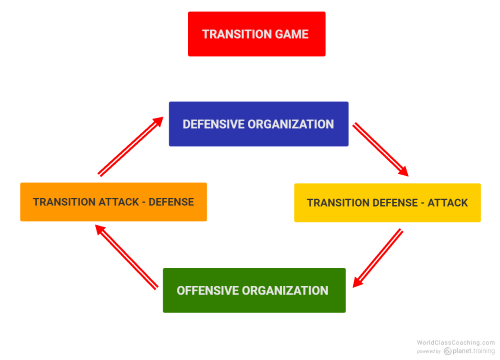
Stopped ball is a special phase of the Soccer game when you have the ball possession with space and usually without a closer defense. This provides you an opportunity to organize your offensive move.
If your team is defending in a stopped ball situation you have to train your players to defend your Goalkeeper, positionanting them between the ball and the Goal and warning about the opponent's movement.
You have to create and train some to decide which will be used in each situation.
On Stopped ball will have situations for:
(A) Free kicks;
(B) Corners;
(C) Side balls;
(D) Build ins.
It's important to train more than one ball stopped situation in order to difficult to your opponent to predict what are you going to do.
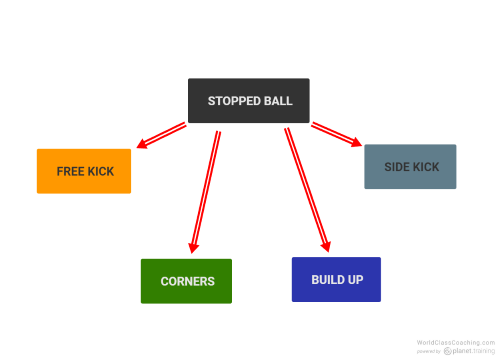
With all this concepts defined you can start training your team. That's what I did.
I defined how I want my team to play in all game phases and use all this exercises to help me.
My idea here is to provide to you all some exercises that can help you in your team, but you have to have all your game ideas clear in your head.
Here's five chapters with 22 exercises and variations that might help you training the 5 phases of the Soccer Game.
All these exercises can be use at any age with a correct adaptation.
You can also think outside the exercises, creating some variations or adaptations that can fit better in yor team.
That's the beauty of Soccer.
It's so many ideas that we can sit, talk about, discuss for long hours without stop.
And we can write a thousand books and we still have new exercises, new ideas coming.
Good study and good read.
Renato.
TABLE OF CONTENTS
CHAPTER 1 – 6x6 games situation
. 6x6 + 5 Goalies
. 6x6 + 6 Goalies
. 6x5 Attack x Defense game
. 6x6 Transition game with a 6x5 initial game situation
. 6x6 Dynamic game + 6x3 game situation
. 6x4 with 2 support players
CHAPTER 2 – 5x5 games situation
. 5x5x5 game
. 5x5x5 Caotic game
. 5x5 + 5x5 game situation
. 5x5 with 2x1 into Offensive areas
. 5x7 + 7x7 Attacking with long pass
CHAPTER 3 – 4x4 games situation
. 4x4 with a 3x2 or 4x2 duel
. 4x4x4 Transition game
. 4x4 Transition game
. 4x4 + 1 with 4 goalies game
. 4x4 with 1 Player action zone
. 4x4 with 4x3 Transition game
CHAPTER 4 – 3x3 games situation
. 3x3 Transition game with a 3x2 initial game situation
. 3x3 Transition game with a 2x2 game into Offensive areas
. 3x3x3 Transition game
CHAPTER 5 – Other games situation
8x8 with a 8x4 Changing spot game
11x11 with 1 Touch game
CHAPTER 1 – 6x6 situation games
6x6 + 5 Goalies:
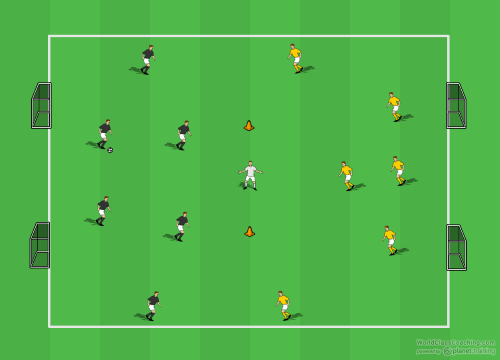
Setup:
13 players
A 40x35 meters game field
Execution:
Two teams with 6 players.
The game will be playing in a 6x6 game situation.
Each team will defend the two small goalies.
A Goalkeeper will play for the team who is defend.
The attack can kick from anywhere in the field at any goalie they want: (A), (B) or (C).
The defense have to recovery the ball to counter attack.
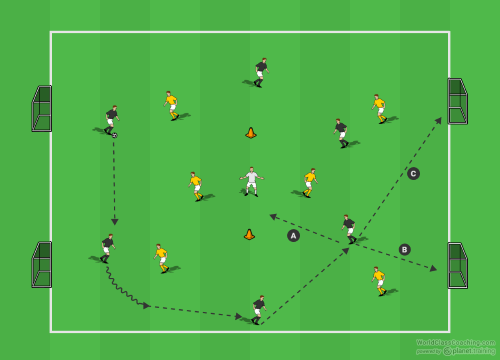
Variations:
. You can increase or decrease the number of players involved;
. You can increase or decrease the number of goalies defended;
. You can move the goalies, putting it in different places into the field;
. You can set where the attack can kick to any goalie;
. You can vary the position of the Goalkeeper;
. You can define a number of touch on the ball for each player.
6x6 + 6 Goalies:
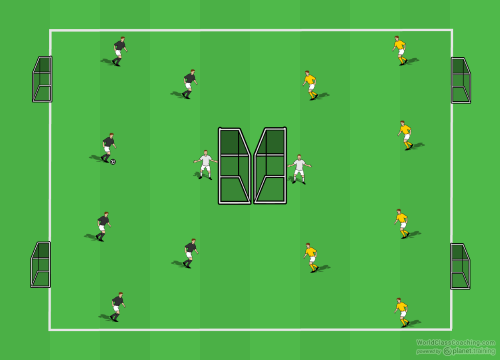
* This exercise is an variation of the 6x6 + 5 goalies game.
Setup:
14 players
A 40x40 meters game field
Execution:
Two teams with 6 players.
The game will be playing in a 6x6 game situation.
Each team will defend the three goalies.
The attack can kick from anywhere in the field at any goalie they want: (A), (B) or (C).
The defense have to recovery the ball to counter attack.
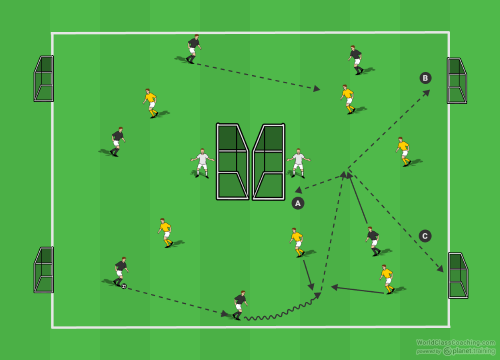
Variations:
. You can increase or decrease the number of players involved;
. You can increase or decrease the number of goalies defended;
. You can move the goalies, putting it in different places into the field;
. You can set where the attack can kick to any goalie;
. You can define a number of touch on the ball for each player;
. You can add Goalkeepers.
6x5 Attack x Defense game:
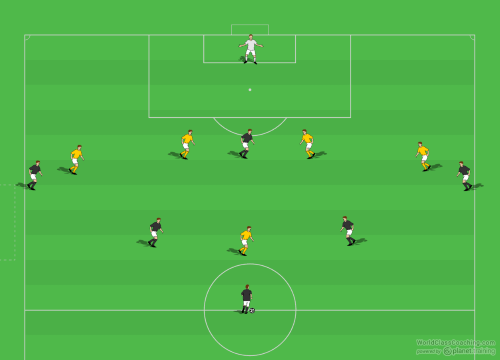
Setup:
14 players
A 55x68 meters game field.
Execution:
This exercise will happen in a 6x5 game situation.
It's a basic Attack x Defense game.
The attack will be positionate in a 3-3 form and the defense will be positionate in a 4-1 form.
Every time the ball leaves the field, without being a side kick or a corner, the exercise restarts.
Variations:
. You can increase the number of players involved;
. You can add one more Goalkeeper and doing a transition game;
. You can vary the formation of defense or attack.
6x6 Transition game with a 6x5 initial game situation:
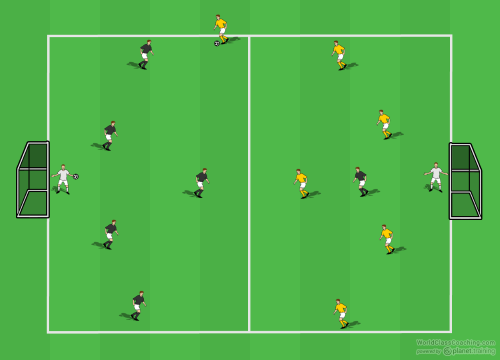
* This exercise is a variation of the 5x5 Transition game with a 5x4 initial game situation
Setup:
14 players
40x35 meters game field
Execution:
Divide two teams with 6 players to each one.
One defender will be defined to start with one ball to kick into the opponent goalie.
One attacker will start into offensive field while the others five attackers will be positionate near to their Goalkeeper to start the exercise.
The game will be playing in a 6x5 game situation in these situations:
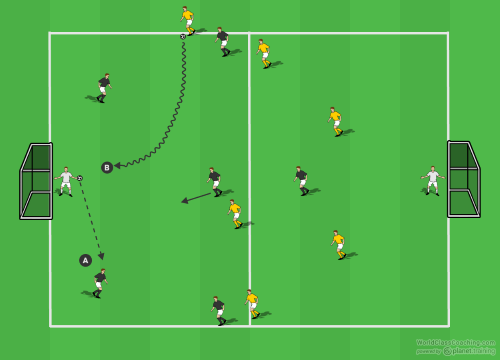
(A) The Goalkeeper will start the exercise touching the ball for a back four line.
This line will build up the offensive game for the attack.
(B) The defender who have the ball will attack the opponent Goalkeeper.
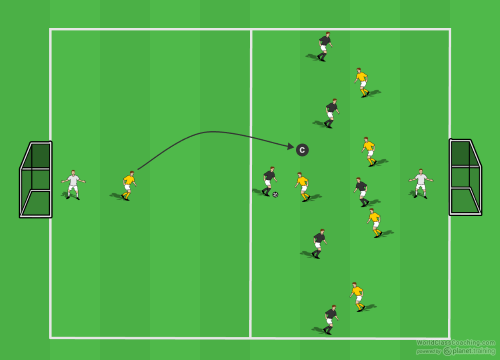
(C) After attacking, the defender will try to recovery his position into defense, avoinding the offensive majority.
If the defender recoveries his position the exercise will be play in a 6x6 game situation.
The attack have to build up his movement ordenatly, the Goalkeeper cannot make a long pass directly to his attack field.
If the defense recoveries the ball possession, they will have the counter attack.
If the ball leaves the field, without being a corner kick or a lateral, the exercise will restart.
Variations:
. You can increase or decrease the number of players involved;
. You can vary the build up formation using 3 players instead of 4 for example;
. You can define the type of kick for a defender starts the exercise;
. You can vary the game field size.
6x6 Dynamic game + 6x3 game situation:
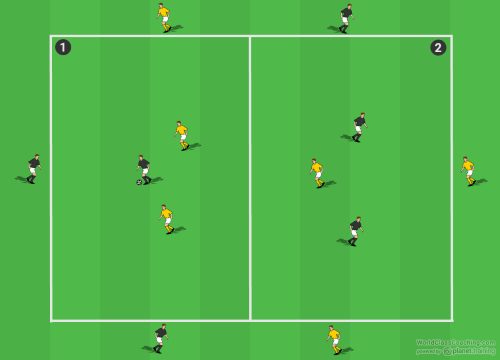
Setup:
12 players
20x20 meters game field
Execution:
Divide two teams with 6 players to each one.
Divide the field in two:
(a) Field 1;
(b) Field 2;
At Field 1 put 3 attackers and 3 defenders.
One attacker wil be inside the Field 1 and the other 2 will be outside.
Two defenders will be inside Field 1 and one will be outside.
At the Field 2 you will have two attackers inside and one outside with one defender inside and two outside.
The game will be playing in a 3x3 game situation inside the fields but the attack can play with the three outside players.
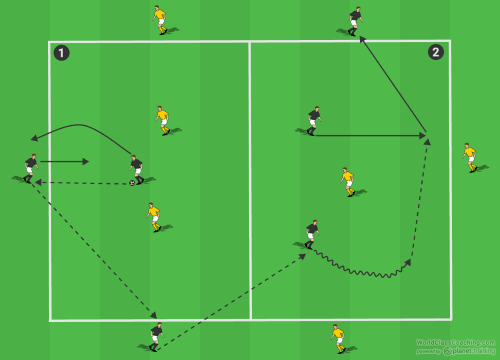
Players can change position between them anytime they want but without leaving any space empty.
The outside attackers cannot touch the ball directly between them. The ball have to pass inside the field or the attack looses possession.
If the defense recovery the ball possession they will start touching the ball between them.
Variations:
. You can increase or decrease the number of players involved;
. You can vary the inside game situation;
. You can allow outside players to mark;
. You can limit the number of touches on the ball by each player.
6x4 with 2 support players:
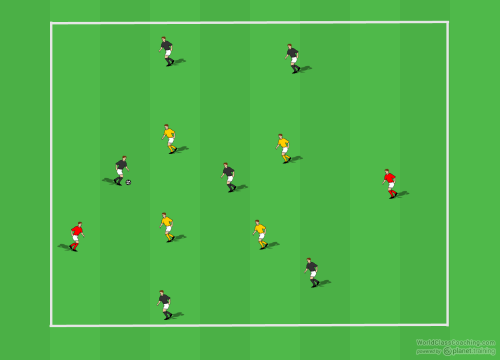
Setup:
12 players
A 40x20 meters game field.
Execution:
This exercise will happen in a 6x4 game situation.
The attack have to touch the ball between then without losing the ball possession.
Two possession players will play with the attack to create the offensive majority.
The defender who gets the ball possession switch position with the attacker who looses the ball.
If one support player looses the ball he won't switch position with the defender. The attacker next to him will go defend in his place.
Variations:
. You can increase the number of players involved;
. You can vary the game field area;
. You can limit the number of touches on the ball by each player;
. You can increase or decrease the number of support players
. You can define a number of touches to worth 1 point.


